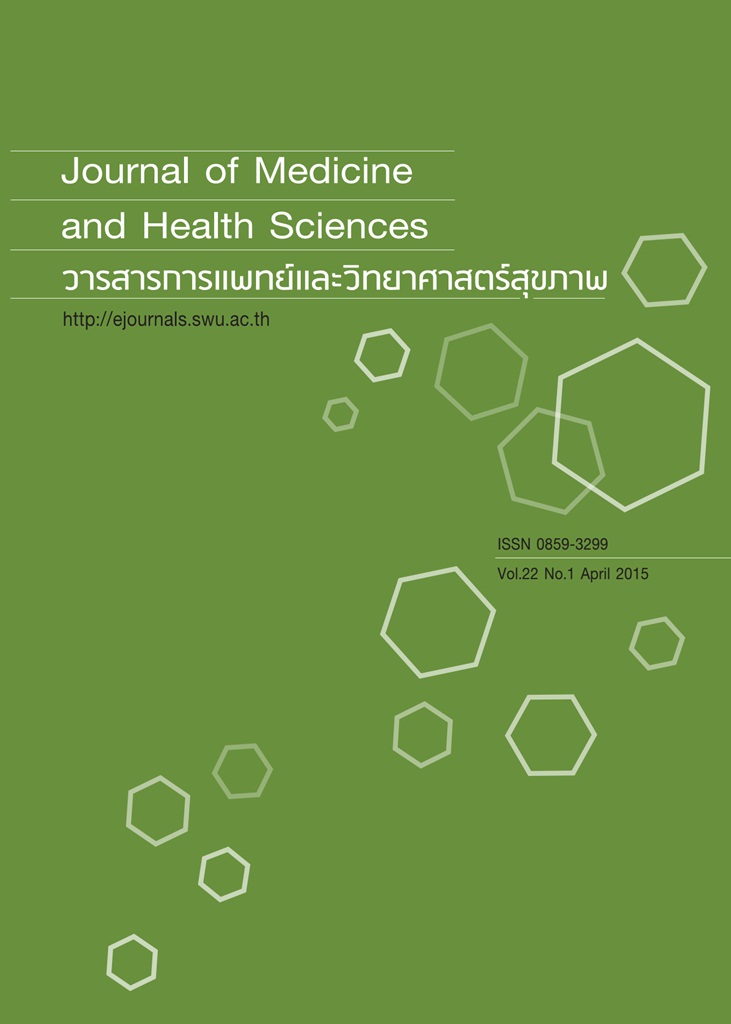Nosocomial infection
Keywords:
โรคติดเชื้อในโรงพยาบาล, Pseudomonas aeruginosa, Klebsiella spp., Acinetobacter baumannii, Methicillin resistant Staphylococcus aureus, EnterococciAbstract
Nosocomial infection is one of the important problems that occur with patients who were admitted in the hospital. It can be found in all level of hospitals and the numbers of cases increase every year. This infection leads to increase severity of the disease and prolong of hospitalization. Nosocomial infection was diagnosed by analyzing information such as medical history, signs and symptoms, and laboratory identification. The most common sites that nosocomial infection can be found are respiratory tract, urinary tract, and surgical site. The commonly found pathogens are Pseudomonas aeruginosa, Klebsiella spp., Acinetobacter baumannii, Methicillin resistant Staphylococcus aureus (MRSA), and Enterococci. During last decade, this group of pathogens has developed many antibiotic resistance mechanisms causing the increasing cost and time of new generation antibiotic to eliminate them. The best solution for nosocomial infection is the prevention before the infection occurred and controls the infection when there is a case to stop infecting other patient in the same ward. To make the prevention and control function, all doctors, nurses, and other hospital staffs have to take part in the program which will finally lead to the most efficient and sustainable outcome.
โรคติดเชื้อในโรงพยาบาลและสถานการณ์การดื้อยา
โรคติดเชื้อในโรงพยาบาลเป็นปัญหาสำคัญที่เกิดขึ้นกับผู้ป่วยที่เข้ารับการรักษาในโรงพยาบาลที่สามารถพบได้ในโรงพยาบาลทุกระดับ แต่ละปีมีรายงานการพบผู้ป่วยติดเชื้อในระหว่างเข้ารับการรักษาตัวในโรงพยาบาลเป็นจำนวนมากซึ่งเป็น สาเหตุให้อาการของผู้ป่วยมีความรุนแรงขึ้นหรือต้องอยู่ในโรงพยาบาลนานขึ้น การวินิจฉัยการติดเชื้อในโรงพยาบาลสามารถ ทำได้โดยเริ่มจากการซักประวัติผู้ป่วย การตรวจดูอาการ การตรวจทางห้องปฏิบัติการแล้วนำผลการวิเคราะห์มาประกอบ การวินิจฉัยโรค โดยทั่วไปสามารถพบการติดเชื้อในผู้ป่วยจากตำแหน่งสำคัญต่างๆ เช่น ระบบทางเดินหายใจ ระบบทางเดิน ปัสสาวะและแผลผ่าตัดเป็นต้น ซึ่งเชื้อก่อโรคที่พบบ่อยคือ Pseudomonas aeruginosa, Klebsiella spp., Acinetobacter baumannii, Methicillin resistant Staphylococcus aureus (MRSA) และ Enterococci เชื้อกลุ่มนี้มีการพัฒนาการ ดื้อยาเพิ่มมากขึ้นในช่วง 10 ปีที่ผ่านมา ทำให้การรักษามีค่าใช้จ่ายเพิ่มขึ้นและต้องใช้เวลานานในการกำจัดเชื้อให้หมดไป การแก้ปัญหาโรคติดเชื้อในโรงพยาบาลที่ดีที่สุดคือการควบคุมและการป้องกันก่อนเหตุการณ์จะเกิดขึ้น แต่ถ้าเกิดการติดเชื้อใน โรงพยาบาลขึ้นแล้วจะต้องจำกัดการติดเชื้อและรักษาผู้ติดเชื้อให้หายก่อนจะแพร่กระจายเชื้อไปสู่ผู้อื่น ซึ่งการควบคุมและ การป้องกันจะประสบความสำเร็จได้ต้องอาศัยความร่วมมือของบุคลากรทุกฝ่ายในโรงพยาบาล ทั้งแพทย์พยาบาลเจ้าหน้าที่ ทุกฝ่ายเพื่อการควบคุมป้องกันที่มีประสิทธิภาพ และยั่งยืน



